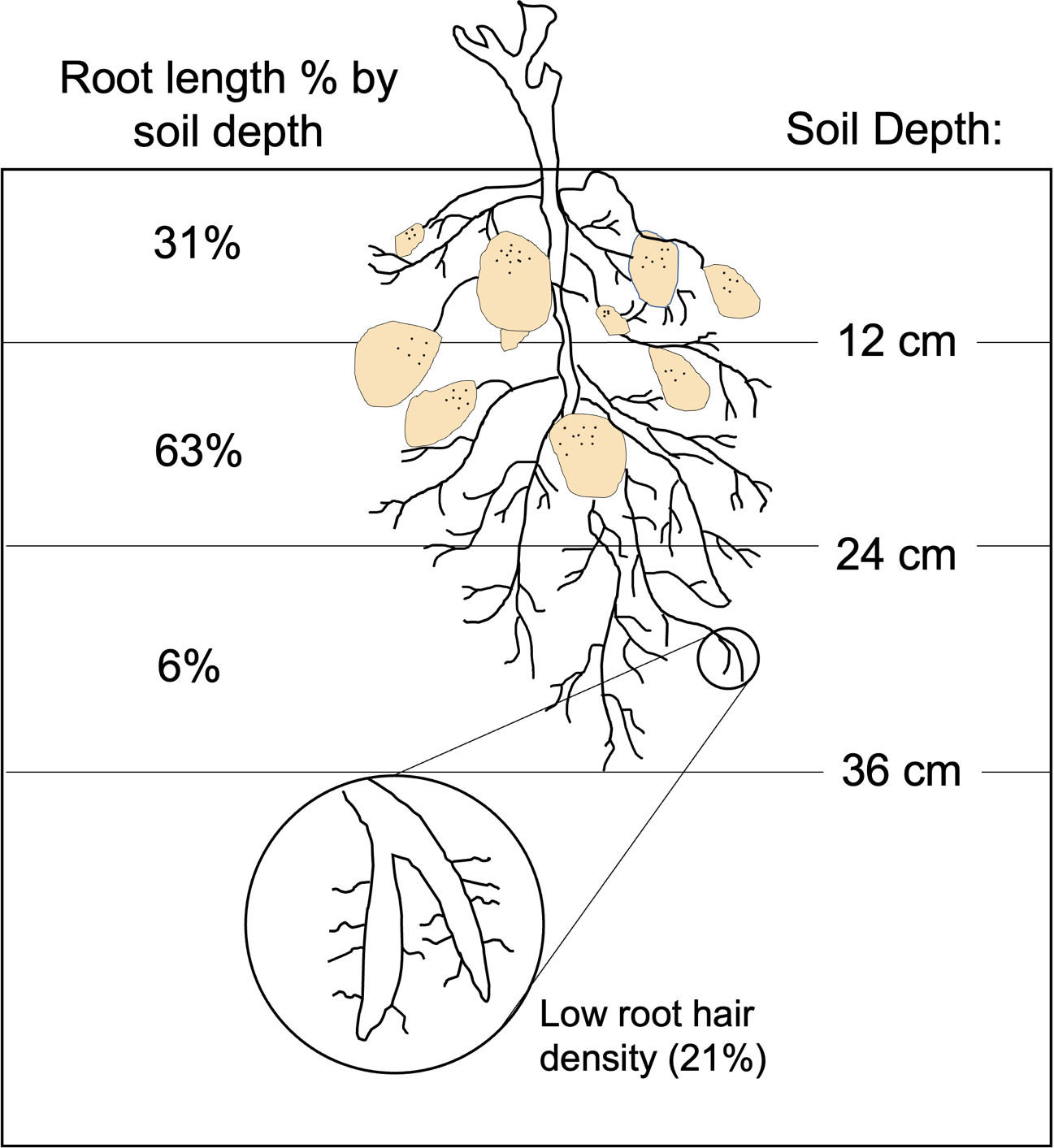Abstract
Florida is one of two states (FL and CA) that produce spring potatoes, FL having the highest crop value out of any state in the country ($469.67 per ton). Due to the low phosphorus use efficiency (PUE), high rates of phosphorus (P) are applied to ensure adequate yields. This has led to a buildup of legacy P, resulting in mehlich-1 levels as high as 375 mg kg-1. These levels are significantly higher than the critical values for potatoes (25-35 mg kg-1), yet farmers still report increased yields with P applications. Several organic amendments, management practices, and new fertilizers have been shown to help increase P availability in potato cropping systems by reducing P fixation and maximizing the available P fraction throughout the growing season. New fertilizers and management strategies should be researched in the TCAA to find methods that maintain yields while reducing the environmental impact of potato cropping systems.
References
Bittman, S., C. G. Kowalenko, D. E. Hunt, T. A. Forge, and X. Wu. 2006. “Starter Phosphorus and Broadcast Nutrients
on Corn with Contrasting Colonization by Mycorrhizae.” Agronomy Journal 98(2): 394–401. https://doi.org/10.2134/ agronj2005.0093.
Ch’ng, H. Y., O. H. Ahmed, and N. M. A. Majid. 2014. “Improving Phosphorus Availability in an Acid Soil Using
Organic Amendments Produced from Agroindustrial Wastes.” The Scientific World Journal 2014: 16. https://doi.
org/10.1155/2014/506356.
Cui, S., Y. Qin, J. Yu, X. Shi, L. Jia, and M. Fan. 2020. “Improving Tuber Yield and Phosphorus Use Efficiency
Using Split Phosphorus Application to Potatoes in Inner Mongolia.” American Journal of Potato Research 97: 318324.
https://doi.org/10.1007/s12230-020-09783-3.
Fernandes, A. M. and R. P. Soratto. 2012. “Nutrition, Dry Matter Accumulation and Partitioning and Phosphorus
Use Efficiency of Potato Grown at Different Phosphorus Levels in Nutrient Solution.” Revista Brasileira de
Ciência do Solo 36(5): 15281537. https://doi.org/10.1590/S0100-06832012000500017.
Fernandes, A. M., R. P. Soratto, E. F. C. Souza, and A. L. G. Job. 2017. “Nutrient Uptake and Removal by Potato
Cultivars as Affected by Phosphate Fertilization of Soils with Different Levels of Phosphorus Availability.” Revista
Brasileira de Ciência do Solo 41: 123. https://doi.org/10.1590/18069657rbcs20160288.
Grant, C., S. Bittman, M. Montreal, C. Plenchette, and C. Morel. 2005. “Soil and Fertilizer Phosphorus: Effects on
Plant P Supply and Mycorrhizal Development.” Canadian Journal of Plant Science 85(1): 314. https://doi.org/10.4141/
P03-182.
Hochmuth, G., and K. Cordasco. 2008. “A Summary of N, P, and K Research on Potato in Florida: HS756.” EDIS 2008
(4): 1–22. https://ucanr.edu/sites/nm/files/76620.pdf.
Hochmuth, G., P. Weingartner, C. Hutchinson, A. Tilton, and D. Jesseman. 2002. “Potato Yield and Tuber Quality did
not Respond to Phosphorus Fertilization of Soils Testing High in Phosphorus Content.” HortTechnology 12(3):
–423. https://doi.org/10.21273/HORTTECH.12.3.420.
Hopkins, B. G. 2013. “Russet Burbank Potato Phosphorus Fertilization with Dicarboxylic Acid Copolymer Additive
(AVAIL®).” Journal of Plant Nutrition 36(8): 1287–1306. https://doi.org/10.1080/01904167.2013.785565.
Hopkins, B. G., D. A. Horneck, and A. E. MacGuidwin. 2014. “Improving Phosphorus Use Efficiency through
Potato Rhizosphere Modification and Extension.” American Journal of Potato Research 91(2): 161–174. https://doi.
org/10.1007/s12230-014-9370-3.
Kelling, K. A., R. P. Wolkowski, P. E. Speth, and T. W. Andraski. 2020. “Interaction of Fertilizer Phosphorus Rate
and Placement/Timing on Potatoes.” American Journal of Potato Research 97(4): 420–431. https://doi.org/10.1007/
s12230-020-09784-2.
Kolbe, H., and S. Stephan-Beckmann. 1997. “Development, Growth and Chemical Composition of the Potato Crop
(Solanum tuberosum L.). I. Leaf and Stem.” Potato Research 40: 111–129. https://doi.org/10.1007/bf02407567.
Liao, X., G. Liu, B. Hogue, and Y. Li. 2015. “Phosphorus Availability and Environmental Risks in Potato Fields in
North Florida.” Soil Use and Management 31(2): 308–312. https://doi.org/10.1111/sum.12186.
Little, S. A., P. J. Hocking, and R. S. B. Greene. 2004. “A Preliminary Study of the Role of Cover Crops in Improving
Soil Fertility and Yield for Potato Production.” Communications In SoilScience and PlantAnalysis 35(34): 471–494.
https://doi.org/10.1081/CSS-120029726.
Munoz-Arboleda, F., R. S. Mylavarapu, C. M. Hutchinson, and K. M. Portier. 2006. “Root Distribution under SeepageIrrigated Potatoes in Northeast Florida.” American Journal of Potato Research 83(6): 463472. https://doi.org/10.1007/
BF02883507.
Rosen, C. J., K. A. Kelling, J. C. Stark, and G. A. Porter. 2014. “Optimizing Phosphorus Fertilizer Management in
Potato Production.” American Journal of Potato Research 91(2): 145160. https://doi.org/10.1007/s12230-014-9371-2.
Ruark, M. D., K. A. Kelling, and L. W. Good. 2014. “Environmental Concerns of Phosphorus Management in Potato
Production.” American Journal of Potato Research 91(2): 132–144. https://doi.org/10.1007/s12230-014-9372-1.
Selladurai, R. and T. J. Purakayastha. 2016. “Effect of Humic Acid Multinutrient Fertilizers on Yield and Nutrient Use
Efficiency of Potato.” Journal of Plant Nutrition 39(7): 949–956. https://doi.org/10.1080/01904167.2015.1109106.
Setu, H. and T. Mitiku. 2020. “Response of Potato to Nitrogen and Phosphorus Fertilizers at Assosa, Western
Ethiopia.” Agronomy Journal 112(2): 1227–1237. https://doi.org/10.1002/agj2.20027.
Sharpley, A., T. C. Daniel, J. T. Sims, and D. H. Pote. 1996. “Determining Environmentally Sound Soil Phosphorus
Levels.” Journal of Soil and Water Conservation 51(2): 160-166. https://login.lp.hscl.ufl.edu/login?url=https://
www.proquest.com/scholarly-journals/determining-environmentally-sound-soil-phosphorus/docview/220969749/
se-2?accountid=10920.
Simonne, E. H. and G. J. Hochmuth. 2019. “Soil and Fertilizer Management for Vegetable Production in Florida:
HS711/CV101, Rev. 11/2006.” EDIS 2006: 3–15. https://doi.org/10.32473/edis-cv101-2006.
Soratto, R. P., C. Pilon, A. M. Fernandes, and L. A. Moreno. 2015. “Phosphorus Uptake, Use Efficiency, and Response
of Potato Cultivars to Phosphorus Levels.” Potato Research 58(2): 121–134. https://doi.org/10.1007/s11540-015-9290-8.
Thornton, M. K., R. G., Novy, and J. C. Stark. 2014. “Improving Phosphorus Use Efficiency in the Future.”
American Journal of Potato Research 91(2): 175–179. https://doi.org/10.1007/s12230-014-9369-9.
USDA, National Agriculture Statistics Services. 2020a. Potatoes 2019 Summary. ISSN: 1949–1514.
USDA, National Agriculture Statistics Services. 2020b. Agricultural Statistics 2019.
Van Zeghbroeck, J., G. Liu, R. S. Mylavarapu, and Y. C. Li. 2021. “Phosphorus Management Strategies for Potato
Production in Florida: a Review.” American Journal of Potato Research 98: 347–360. https://doi.org/10.1007/
s12230-021-09851-2.
Worthington, C. M. and C. M. Hutchinson. 2005. “Accumulated Growing Degree Days as a Model to Determine
Key Developmental Stages and Evaluate Yield and Quality of Potato in Northeast Florida.” In Proceedings of the Florida
State Horticultural Society 118, edited by Ed Etxeberria, 98–101.

